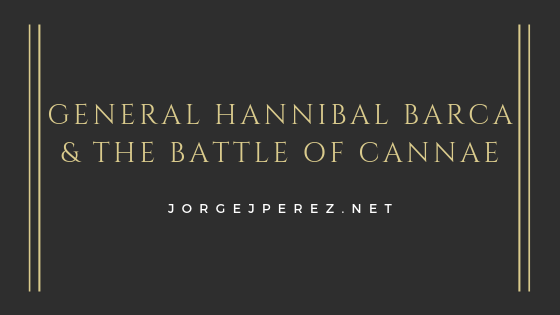The Battle of Cannae was the worst defeat suffered by Roman armies in the history of the Republic and Empire. It occurred during the second of the three Punic Wars, which were fought between Rome and Carthage over mastery of the western Mediterranean. These wars began as a dispute over territory and trade routes between Rome and Carthage. Its outcome would change the history of the world.
In 216 B.C., the Carthaginian General Hannibal Barca led his troops of roughly 50,000 infantry and cavalry to a dusty plain to fight against just under 100,000 Romans. This battle was a great victory and testament to Hannibal’s military skills, but such a defeat was not the end of the conflict between the two empires.
Hannibal Barca
Regarded as one of the most prolific and competent military leaders in history, General Hannibal Barca was a dominating force of the Carthaginian army. Born during the conclusion of the First Punic War, Hannibal was directly affected by the Roman Siege of Sicily and a Carthaginian Civil War.
His father, Hamilcar Barca, was also a general, and his father’s personal and professional connection to the feuds with Rome were arguably instrumental in the instillation of Hannibal’s antipathy for Rome and its people.
Upon his father’s death, Hannibal’s brother-in-law, Hasdrubal the Fair, was appointed as governor. As his name suggests, he was a diplomatic leader who encouraged the improvement of the Carthaginian status through intermarriage, namely to Iberian citizens. He united Carthage and many of the Iberian tribes in an attempt to strengthen the city-state, and when he died, Hannibal took his position.
Hannibal was elected to be the commander of the Carthaginian forces in 221 at the age of twenty-six. His methods were much akin to his father’s tactics as he employed a strong militaristic presence and ambitious attacks on native populations and Roman allies.
Prior to directly conducting battle with the Romans, Hannibal attempted to sway the Roman allies through diplomacy, but when this effort failed and Rome raised their army, he resorted to his military background and agreed to do battle.
By utilizing the double envelopment strategy and his militaristic prowess, Hannibal managed to overpower the Roman forces, earning a victory for the North African city-state of Carthage. In Rome, Carthage faced an enemy unlike any other, one that would never surrender. For the Romans, this became an existential struggle and total war.
Double Envelopment
Hannibal’s attack on Rome is regarded as one of the most prominent and effective examples of the military tactic known as double envelopment or the “pincer” movement. This tactic is believed to have existed for more than 2,000 years. The basic construction of this tactic entails flanking an enemy force on both sides with the ultimate goal of cutting them off from their base, resources, and reinforcements.
Hannibal’s execution of this tactic could be considered textbook. By arranging his troops in a hollow crescent, he allowed the Roman troops to gain some ground while his cavalry defeated the flanking Roman forces before encircling the main force. Hannibal effectively surrounded the Roman forces, leading to their defeat.
He was deliberate in his tactics, designating where certain troops would be positioned based on their strength and ability. At the center of his trap, he positioned the Celts and Spaniards, flanking these troops with his Libyan infantry; the latter were reportedly more experienced and capable, making them a valuable asset in the fight. The reason Hannibal arranged his troops this way was to grant the Roman forces an illusory opportunity, allowing them to press forward while Hannibal’s stronger fighters surrounded them from behind. Because of his genius and ultimate victory, Hannibal’s execution remains a highly-regarded example of double envelopment.
Environmental Factors
In addition to Hannibal’s military prowess, there were several elements of the area in which the battle commenced that contributed to the Carthaginian victory. Hannibal strategically took command of the Aufidus River, which was the largest resource of fresh water within the area; due to the dry August heat, this became a significant advantage. Likewise, Hannibal approached this area facing the north, forcing the Roman forces to face south; hot winds blew directly into the Roman troops, sending dust, dirt, and grit into their eyes.
Hannibal also managed to confine the Roman troops in a narrow valley, requiring them to maintain a deep, rather than a wide, formation. This manipulation of the Roman militia was deliberate, working into Hannibal’s plan for entrapment and the ultimate Carthaginian victory.
The region Hannibal selected was also known to be a primary source of grain and other food resources for the Romans; from the beginning, Hannibal sought to contend the Roman forces through a battle of wits, strength, and attrition.
Rome Rises
The Romans suffered a devastating loss, enduring more than 50,000 casualties. Hannibal’s legendary victory is still remembered and regarded as an incredibly successful battle and an example of military genius. The defeat was seared into the Roman consciousness and convinced the people and the Senate of Rome that there could only be one outcome in its conflict with Carthage – “Carthago delenda est“(“Carthage must be destroyed”) – a phrase the great Roman Senator, Cato the Elder, would utter after every speech he gave, regardless of the topic.
In spite of Carthage’s monumental victories, Rome was far from defeated. It recovered and prioritized strengthening its defenses, refusing Hannibal the opportunity to march on Rome and lay siege to the growing empire.
In 202 B.C., the Roman general, Scipio Africanus, who was present at the defeat at Cannae and had carefully studied Hannibal’s tactics, vowed to avenge Rome and restore her honor. In 201 B.C., Scipio Africanus led a Roman Army to Africa, directly threatening Carthage itself. Although unbeaten, Hannibal was recalled to Carthage to defend it against advancing Roman legions. Scipio Africanus had learned much from Hannibal, namely to always attack when and where the enemy least expected. Thus, in abandoning Italy, all of Hannibal’s great victories came to naught.
In 201 BC, at the battle of Zama in Africa, Hannibal suffered his first decisive defeat. It was at the hands of Scipio Africanus. Hannibal finally understood that a war with such uniquely fearsome people was a strategic mistake, one that would be fatal for Carthage. The Carthaginians, in fear, handed over to Rome all of its provinces in Spain, thus ending the Second Punic War. But for Rome, peace was simply a pause in what it saw as a war of annihilation against Carthage.
Decades later, in 149 B.C., Rome picked a quarrel with Carthage to begin the Third (and final) Punic War. For Rome, this war would have only one ending. Despite Carthaginian attempts to seek peace, the Romans utterly destroyed Carthage in 146 B.C., enslaved the surviving population, and reduced the great city of Carthage to rubble. Legends tell us that the Romans even sowed the land under Carthage with salt so nothing would ever grow there again.
Hannibal fled to Bithynia where he allied himself with the king, Prusias I, in his battle against the city of Pergamon. Rome, however, aligned itself with Pergamon, and in order to escape deportation and a very public execution in Rome, Hannibal poisoned himself.
His legacy as a prolific leader and impressive military figure still remains strong. Hannibal was the last to challenge the Roman empire for nearly six centuries, and his remarkable victory in the Battle of Cannae is still regarded as an impressive demonstration of political and military prowess.
___
Jorge J. Perez is an attorney in South Florida. He is a self-professed history buff. Visit JorgeJPerez.net often to learn more.

